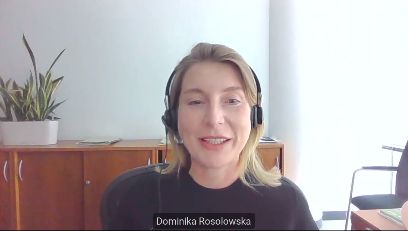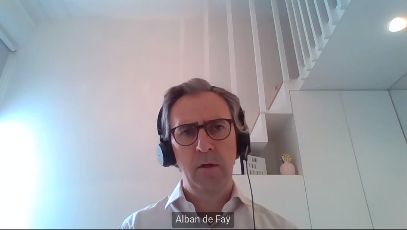KEITH MULLIN, KM CAPITAL MARKETS: A VERY WARM WELCOME TO THIS IFR WEBINAR ON ESG CAPITAL MARKETS. I’D LIKE TO KICK OFF BY ASKING EACH OF OUR ISSUERS TO DO A QUICK REVIEW OF THEIR ESG DEBT ISSUANCE IN 2020 AND 2021 YEAR-TO-DATE.
Dominika Rosolowska, EIB: I represent the sustainability funding team at the EIB, which is responsible for structuring and issuing the two use-of-proceeds products we have – Climate Awareness Bonds (CABs) and Sustainability Awareness Bonds (SABs) – across all currencies and formats. For us, last year was a record year in terms of issuance. CABs and SABs contributed 15% of EIB’s overall funding programme of €70bn. We issued more than €10.5bn-equivalent across these two products. Such an increase in issuance – it was more than a two-fold increase versus 2019 – was made possible thanks to the way we structured the use-of-proceeds documentation for these bonds.
Essentially, we made reference in documentation to evolving EU sustainable finance legislation, and the EU Taxonomy Regulation in particular. This permits us to add new areas of the bank’s activity in modular fashion as they become mapped according to the framework of the EU Taxonomy Regulation. Importantly, last year, we added Covid-19 emergency response as an area under our SAB framework, and we were able to increase multiple times the volume of SABs issued last year.
This year, another addition to our SAB framework was the inclusion in January of another objective under the EU Taxonomy Regulation: the protection and restoration of biodiversity and ecosystems. The first new activity that we added corresponding to this objective was sustainable forest management. Biodiversity is a topic that is very much in focus at the moment and is one of the objectives the EIB is pursuing on the lending side.
Coming back to currencies and tenors for our CABs and SABs, there haven’t been too many shifts. Euros and the US dollars are the two currencies EIB as an institution uses predominantly for its funding. That is reflected in our CAB and SAB issuance. Euros contributed around half of our use-of-proceeds issuance last year.

However, this year we were able to access other markets such as the Australian dollar and Canadian dollar markets, with large transactions. We launched the largest-ever green Kangaroo bond and the largest and longest-ever Climate Awareness Bond in Maple format.
We try to diversify our funding sources, to access new investors and diversify our investor base through the issuance of CABs and SABs. Some of these new additions this year, for instance, included the offshore renminbi issue that we did in syndicated format.
[The EIB priced a A$1.25bn (US$1.08bn) 6.5-year Kangaroo CAB and a C$1bn (US$820m) seven-year Maple CAB in January; and a Rmb1bn (US$156m) CAB in April.]
As for the market and the reception of investors to our strategy, this has been positive. We received a strong reception to the modular or gradual enlargement of our CAB/SAB eligibility criteria, allowing for the inclusion of the Covid-19 emergency response last year and biodiversity this year. As well as a strong response from investors, we are also able to access investors we see a bit less frequently in our [conventional] books as well as investors that showed up in our books for the first time, and are attracted by the CAB/SAB format.
Frank Richter, NRW.Bank: Labelled bonds are becoming more important for us. Just to briefly recap, NRW.Bank is a German regional development agency, and, of course, fighting climate change is one of our core priorities. We have been active in the green bond market since 2013–2014 on a more or less regular basis. Our approach is always to be state of the art and to push market standards.
Our US$500m 10-year green bond of January was aligned with the EU Green Bond Standard and with the EU Taxonomy. In general market terms, I would say Covid-19 was a catalyst for lifting the labelled bond market to the next stage. We responded to this with our huge portfolio of social activities in the region, and we brought our first social bond to the market in summer last year – a €1bn due 2035.
From a currency perspective, we are clearly focused on euros, also given our limited requirement of around €12bn–€13bn on average over the years. In percentage terms, when we started issuing labelled bonds, they contributed around 5% of our annual funding volume. Last year, we reached 12%–13% and I expect this will rise to close to 20% or maybe even more in 2021.
We have accelerated our loan business on the environmentally friendly project side, so that means mitigation and adaptation projects. On the other hand, our social bonds will refinance projects aimed at promoting affordable housing for families, protecting and creating jobs, and supporting municipalities, including in education.
Beyond our issuance in euros, we started our efforts in the Australian dollar market. We have now done two social bonds in Australian dollars. The euro and Australian dollar markets are most relevant for us. We are able to achieve the duration we need for our asset liability management. Longer tenors were available for us in Europe and in Australia.
Over the next few months and into 2022, I expect the importance and the relevance of labelled bonds will increase further. Given the demand for transparency in the capital markets, I expect our labelled green and social bonds will account for close to one-third of our funding volume, most likely in euros and Australian dollars.
Ralf Berninger, SFIL: We are a French local government and export financing agency and, as a local government lender, financing green and social projects is a core part of our activity. We run two issuance programmes. We have a social programme, which has been set up to finance investments in French public hospitals, and we have a green programme that finances green investments by French local authorities.
We are a regular issuer in both markets; we try to do two ESG benchmarks per year, and we are active in two markets. We are a covered bond issuer via Caisse Française de Financement Local (Caffil), and we are an SSA issuer via SFIL in the agency market.
Looking at last year, we did a social bond in April – a €1bn covered bond – during a period when there was still a lot of market uncertainty concerning the impact of the Covid-19 pandemic. And we did our green benchmark in November – a €500m seven-year. That was our first green benchmark not issued in covered format but via SFIL in the agency market. This year, we did a €750m eight-year social covered bond in April. What we still plan to do this year is a green bond. Obviously, this depends a little bit on green lending activity.

What did we learn from the year? First of all we saw that ESG issuance made a significant contribution to widening our investor base. We had a lot of investors in the books that have not previously invested in our transactions.
The big priority for us is to develop our green lending. As a local government lender, we finance investments in areas such as public transport, and water and waste management, but traditionally we lend to the overall investment budgets of municipalities. In this regard, what we’re developing is dedicated green loans where proceeds are used for specific green investments.
KEITH MULLIN, KM CAPITAL MARKETS: LET’S MOVE ON TO THE OTHER SIDE OF THE COIN, FROM THE ISSUERS TO THE BUYSIDE. ALBAN, I’D LIKE TO ASK YOU HOW YOU SET YOUR PRIORITIES AND HOW THAT INFORMS YOUR PROCESSES. ESG INVESTING IS CLEARLY MORE THAN A TICK-BOX ExERCISE. YOU HAVE RESPONSIBILITIES TO CLIENTS AND TO REGULATORS. CAN I ASK YOU TO MAKE SOME COMMENTS ABOUT HOW YOU THINK ABOUT INVESTING IN THIS MARKET?
Alban de Faÿ, Amundi: Responsible investment is one of Amundi’s four strategic pillars and we have been working for years to improve the way we manage our clients’ money. One of our recent goals was the 2021 ESG plan, which was to have 100% of our open-ended funds fully ESG-integrated. We have achieved that goal and it represents roughly €700bn under management.
As we were moving to achieve this goal, the idea was to act as a responsible investor and take into account responsible criteria when we are investing, around what is the impact, first, with regard to the financial aspects of the company but also the impacts on society.
We fully integrate ESG criteria into our processes and use internal ratings for this. A lot of clients want more and more transparency, as the issuers have already highlighted. We are now moving from ESG integration that assures clients that we are taking into account all the information we have that has financial materiality to trying to evaluate the impact on society.
We have moved on ESG mainstreaming and are pushing this on the product side. On the fixed income side, we are quite happy with the development of use-of-proceeds bonds. We are able to build some dedicated strategies to finance energy transition and, thanks to the acceleration of the social bond market, we have also some dedicated strategies on social bonds.
As an investor, we have to do additional work when we look at green bonds, since at this stage, green bonds are self-labelled by issuers. There are some standards, like the Green Bond Principles. Amundi sits on the GBP’s executive committee and we try to defend the interests of investors. It helps to have standardised information but we still have some homework to do to look at how issuers can provide the information we need to be sure that the projects they are financing are aligned with our philosophy.
We try to use green bonds as an instrument to provide impact strategy. More and more of our clients want to assess the impact of their investments. Green bonds and social bonds are very nice tools to respond to client needs in this regard. We are also taking into account sustainability-linked bonds.

For us, this is a quite interesting tool because it allows all types of issuers to explain what their sustainable goals are in the medium to long term. And it’s a way for us to engage in dialogue with issuers.
On the fixed income side, the idea is to integrate ESG criteria into each step of our processes to move from impact and thematic strategies to offer deeper ESG strategies and, also, to engage in dialogue with issuers and to carry out our role as a responsible investor to help a company to move in the right direction, and challenge them to provide more and more information.
We do have some pressure, not just from clients but also from regulators, to provide more and more information about how we manage our strategies and what kinds of ESG criteria we use. To do that, we need more information from companies. One of the key challenges today is to have more and more data from companies. If we don’t receive the information we need, companies are, in most cases, penalised by default of information.
No information is bad information when it comes to ESG, so companies have to be aware that we need more and more information – more than the regulators are asking issuers for. Regulators use investors to put pressure on issuers, and it’s true that sometimes we have to challenge issuers to get the right information. If we don’t receive it, in some cases, we do not invest.
That’s roughly our key challenge on the fixed income side as an investor. On the plus side, the fixed income market is a way for issuers to better explain their sustainable strategies. But we also have to do some additional work to avoid ESG-washing regarding market information.
To see the digital version of this report, please click here
To purchase printed copies or a PDF of this report, please email gloria.balbastro@refinitiv.com


